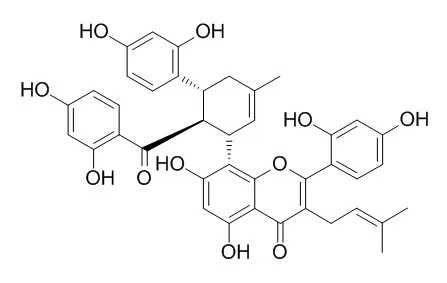| Kinase Assay: |
| Biochem Biophys Res Commun. 1995 Aug 15;213(2):594-9. | | Non-peptide bombesin receptor antagonists, kuwanon G and H, isolated from mulberry.[Pubmed: 7646517] |
METHODS AND RESULTS:
Kuwanon G and H, isolated from the methanol extract of Morus bombycis, inhibited specific binding of [125I]gastrin-releasing peptide (GRP) to GRP-preferring receptors in murine Swiss 3T3 fibroblasts with Ki values of 470 and 290 nM, respectively. Kuwanon H was one order of magnitude less potent for inhibiting [125I]bombesin binding to neuromedin B (NMB)-preferring receptors in rat esophagus membranes. This compound antagonized bombesin-induced increases in the cytosolic free calcium concentration and GRP-induced DNA synthesis in Swiss 3T3 cells.
CONCLUSIONS:
Thus, kuwanon H, and possibly Kuwanon G also, are specific antagonists for the GRP-preferring receptor and can be useful for studying the physiological and pathological role of GRP. |
|
| Animal Research: |
| Phytother Res. 2014 Nov;28(11):1713-9. | | Effect of Kuwanon G isolated from the root bark of Morus alba on ovalbumin-induced allergic response in a mouse model of asthma.[Pubmed: 25116225 ] | The root bark of Morus alba L. (Mori Cortex Radicis; MCR) is traditionally used in Korean medicine for upper respiratory diseases.
METHODS AND RESULTS:
In this study, we investigated the antiasthmatic effect of Kuwanon G isolated from MCR on ovalbumin (OVA)-induced allergic asthma in mice. Kuwanon G (1 and 10 mg/kg) was administered orally in mice once a day for 7 days during OVA airway challenge. We measured the levels of OVA-specific IgE and Th2 cytokines (IL-4, IL-5, and IL-13) in the sera or bronchoalveolar lavage (BAL) fluids and also counted the immune cells in BAL fluids. Histopathological changes in the lung tissues were analyzed. Kuwanon G significantly decreased the levels of OVA-specific IgE and IL-4, IL-5, and IL-13 in the sera and BAL fluids of asthma mice. Kuwanon G reduced the numbers of inflammatory cells in the BAL fluids of asthma mice. Furthermore, the pathological feature of lungs including infiltration of inflammatory cells, thickened epithelium of bronchioles, mucus, and collagen accumulation was inhibited by Kuwanon G.
CONCLUSIONS:
These results indicate that Kuwanon G prevents the pathological progression of allergic asthma through the inhibition of lung destruction by inflammation and immune stimulation. |
|
| Structure Identification: |
| Biomed Chromatogr. 2018 Jul 5:e4328. | | Comparative study of chemical composition and active components against α-glucosidase of various medicinal parts of Morus alba L.[Pubmed: 29975423] | Morus alba L has long been used as fodder and as a traditional medicine. Various parts of M. alba (Cortex mori, Ramulus mori, Folium mori and Fructus mori) have various bioactivities, however, most current evidence focused on anti-diabetic properties. In spite of their wide use, few studies compared the chemical composition and active components against α-glucosidase of the various medicinal parts of M. alba.
METHODS AND RESULTS:
In this study, we developed an HPLC method for simultaneous quality control and discrimination of Cortex mori, Ramulus mori, Folium mori and Fructus mori using thirteen marker compounds. We found that quercetin, morin, Kuwanon G, sanggenon C, morusin, mulberroside A and rutin were chemically distinct among the various medicinal parts of M. alba. A spectrum-effect relationship method was established to compare α-glucosidase inhibitory activity of various batches of samples to determine the activity of the primary active components against α-glucosidase. Taken together with molecular docking data, we found that prenylated flavonoids (morin, sanggenon C, Kuwanon G and morusin), flavonols (kaempferol, quercetin, rutin and isoquercitrin) and alkaloids (1-deoxynojirimycin) were small molecule α-glucosidase inhibitory ingredients.
CONCLUSIONS:
In conclusion, we laid a solid foundation for effective substance identification in various parts of M. alba, and simultaneously provided a basis for their quality control. |
|






 Cell. 2018 Jan 11;172(1-2):249-261.e12. doi: 10.1016/j.cell.2017.12.019.IF=36.216(2019)
Cell. 2018 Jan 11;172(1-2):249-261.e12. doi: 10.1016/j.cell.2017.12.019.IF=36.216(2019) Cell Metab. 2020 Mar 3;31(3):534-548.e5. doi: 10.1016/j.cmet.2020.01.002.IF=22.415(2019)
Cell Metab. 2020 Mar 3;31(3):534-548.e5. doi: 10.1016/j.cmet.2020.01.002.IF=22.415(2019) Mol Cell. 2017 Nov 16;68(4):673-685.e6. doi: 10.1016/j.molcel.2017.10.022.IF=14.548(2019)
Mol Cell. 2017 Nov 16;68(4):673-685.e6. doi: 10.1016/j.molcel.2017.10.022.IF=14.548(2019)